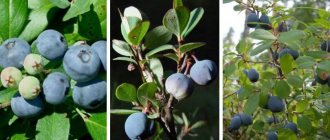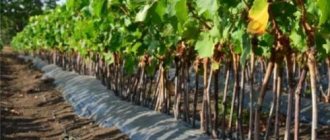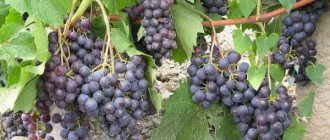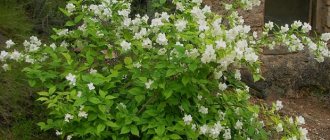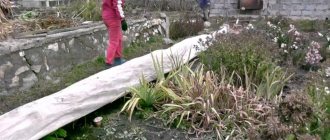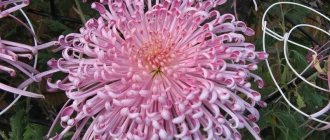From the history of grape cultivation on Siberian soil
The success of growing grapes on Siberian soil was not obvious. During their first attempts at growing grapes, gardeners encountered certain difficulties. Namely: firstly, the grapes for the most part could not withstand harsh weather conditions and froze; secondly, there is a high probability of unexpected spring frosts, which nullify all attempts to grow crops; thirdly, at the end of the season, early autumn frosts can destroy all growth over the summer.
The main factor in failure when growing is the lack of experience in this matter. Gardeners tried to apply agricultural techniques for growing grapes in the central and southern regions, which were not suitable for the Siberian region.
Altai agronomist V.K. Nedin achieved long-awaited success in viticulture in Siberia. Further success was achieved by winegrowers from Biysk. Thus, experience gradually accumulated, and a viticulture system in Siberia was formed. The stages of this system are standard: growing, caring for, harvesting and storing the crop. But agricultural techniques are special; they, of course, differ from traditional ones, and allow the grape culture to feel comfortable in unusual conditions.
In addition, there is a pleasant bonus for Siberian winegrowers: most pathogens are absent here, and harmful insects are not so active.
Types of grapes for Siberia
The first priority is to select a hardy grape variety for Siberia. Southeastern exotics will freeze in winter. Through trial and error, winter-hardy species have been selected that can adapt to abnormal cold. In Siberia, very early grape varieties are used: Valiant, Zolotoy Klyuchik, Muscat, Amursky, Kaya, Venus.
Mid-season species: White Savraska, Muromets, Alpha, Delight. Late-ripening varieties: Obskoy, Reline pink, Biysk-2, Lando Noir.
Seedlings are bought in specialized stores. When purchasing, the cuttings are inspected for mechanical damage. Assess the condition of the root system.
About the specifics of the region
The Siberian Federal District has 12 regions, each with its own climatic characteristics.
Conventionally, the Siberian region is divided into 3 parts:
1) Northern – this includes the Krasnoyarsk Territory (in the northern part), Evenki and Dolgano-Nenets regions;
2) Eastern - this includes the Republic. Buryatia and Tyva, the southern part of the Krasnoyarsk Territory and the Trans-Baikal Territory, Irkutsk region;
3) Western - this includes the Republic. Altai and Khakassia, Novosibirsk, Tomsk, Omsk, Kemerovo regions and Altai Territory.
It became known empirically that the western territories of Siberia produce the largest grape harvest. Early ripening varieties are most suitable for eastern territories.
The main varieties special for the Siberian region produce grapes within 3-4 months.
In western Siberia, with its continental climate, with winter temperatures ranging from minus 15 to minus 30, the height of the snow cover can reach up to 20 centimeters. And the summer sun can heat the air to +15+35C. The climate here is milder, because... with the help of the Altai Mountains, this zone is protected from the Kazakh wind, and with the help of the Vasyugan swamp, the summer heat is mitigated. For this part of Siberia, the right varieties are selected, suitable for such a difficult climate.
In eastern Siberia, with its sharply continental climate, with an average annual temperature of zero, and in winter - up to minus 40, the snow height can reach up to 25 cm. The winter cold is mitigated by calmness. And in summer, despite a good number of sunny days and rare rains, the temperature is no more than +15 degrees. In the north in winter there is a polar night, that is, there is no sun for about 30 days, and on this land there is complete darkness.
Northern Siberia is the harshest climatic area typical of the tundra. There is practically no summer; above-zero temperatures can last 30 days at best. In winter, the air can cool down to minus 40! In mountainous areas there is snow throughout the year.
Features of agricultural technology of Siberian grapes
In summer, the grapevine grows 5-10 cm per day. For this you need to provide adequate nutrition.
If seedlings are planted in the ground without preparation, the nutrients from the top layer are quickly consumed. Because of this, plant growth stops and fruits cannot be expected from them.
With the onset of warm days, holes are prepared for future plantings, drainage is provided and the necessary microelements are added.
How to prepare a planting site:
- A trench 80 cm wide is dug to a depth of 30-40 cm. Under each bush in the trench, an additional hole 60 cm deep is dug, following the pattern: 2 meters between bushes and 3 meters between rows. The total depth is 90 - 100 cm.
- The top layer of soil is removed with a shovel, placed on one side, and the rest of the soil on the other.
- At the bottom of each hole, make a gravel drainage, add a shovel of wood or grass ash and a glass of superphosphate mixed with soil. The soil with fertilizers is covered with branches and coarse grass.
- Mix the deposited top layer of soil, sand and humus (in a ratio of 1:1:0.5). The holes are filled with this mixture to the level of the bottom of the trench and left for 2-3 weeks.
- The walls of a 30 cm high trench are reinforced with boards or any other material in the form of a box.
With such preparation, the soil will have time to warm up well and there will be enough nutrients for many years without additional fertilizing.
For your information! To maintain the soil between the bushes in proper condition, the rows are sown with green manure. This will help redistribute the necessary elements and accumulate humus. At the beginning of flowering, green manure is cut, crushed and used for mulching.
Even if all agrotechnical norms and rules are observed, it is not easy to achieve results if the wrong grape variety is chosen. For Siberia, special frost-resistant early varieties have been bred that can withstand temperatures down to −40°C and produce a harvest.
High-yielding variety. The berries ripen in 100 days.
It grows greatly in width, produces large yields, and requires rationing.
The tasty amber-green fruits with thick skin are collected in large clusters weighing up to a kilogram.
Solovyova-58
By the end of summer it has time to ripen. The whitish fruits have a strawberry-nutmeg taste, are suitable for fresh consumption, and are used for wine and juice. Bunches weighing 200-300 g.
The grapes always take root, do not freeze and are not susceptible to disease. The bush is compact. It is necessary to normalize the harvest and avoid heavy loads.
Memory of Dombkowska
Vigorous, powerful bushes with carved dark green leaves. The berries are large, black, and ripen by early September. The clusters are large and loose. The variety is resistant to diseases and frost.
Sharov's riddle
A common variety in the gardens of Siberia. The fruits ripen at the end of August. The berries are dark blue in color, large, with juicy, aromatic pulp, collected in medium-sized clusters. Cut bunches are stored for a long time.
Codrianca
The high-yielding variety is resistant to diseases, withstands frosts down to −22°C, and ripens in 3 months. The berries are large, up to 8 g, purple in color and pleasant to the taste. The brushes are large, weighing up to 1.5 kg.
About 80 hybrids and varieties were bred for the Siberian region. When purchasing seedlings, pay attention to growth, disease resistance, winter hardiness, size, taste and color of the berries. It is safer to buy planting material in specialized nurseries.
The Vorontsov nursery in Novosibirsk has proven itself well; there are nurseries in Barnaul, Krasnoyarsk, Irkutsk... You can take cuttings and seedlings from experienced gardeners. You cannot buy grapes from random sellers. There is a danger of taking plants that are infected or unsuitable for the local climate.
Growing grapes in Siberia is not easy, but if you follow the recommendations of experienced gardeners, you can achieve harvests no worse than those in the south. The following principles must be followed:
- choose only regionalized varieties of local selection;
- provide regular fertilizing and watering;
- ensure that the plants do not freeze in winter and do not rot during warming;
- harden grapes for resistance to temperature changes;
- normalize the harvest, avoid overloading the vines;
- Carry out autumn pruning in two stages.
Caring for grapes in spring in Siberia will not cause any special problems. Even in Siberian conditions you can grow a decent harvest.
Grapes, traditionally considered a southern crop, have long been successfully grown in Siberia. This opportunity arose not because the harsh Siberian climate softened, but thanks to breeders who developed frost-resistant varieties. However, in short summer conditions, even unpretentious grapes need special care.
The opportunity to grow large and sweet grapes in Siberia is a good gift for gardeners in this region. Varieties have been developed that are adapted to a sharply continental climate with strong fluctuations in both daily and annual temperatures. The warm period without frost here lasts three months: from early June to early September.
Veniaminovich
The peculiarities of growing grapes in Siberia are associated with the early onset of winter. At the same time, the branches do not have time to prepare; full lignification has not yet occurred. As a result, the bush will freeze under any cover. Therefore, the accumulated experience over the years has developed into several postulates;
- breeding only early and regionalized varieties;
- During the season, plants should be hardened off;
- limit fertilization with nitrogen fertilizers;
- grow one fruiting vine per bush;
- regulate the fruit load during budding and filling;
- During the summer, carry out work on the green bush systematically;
- The vines should be pruned only in the fall, twice;
- shelter, snow retention, spring opening of bushes - depending on climatic conditions.
All recommendations are based on the practical introduction of grapes to Siberia, first by agronomist V.K. Nedin from the Altai village of Belokurikha, then by amateur gardeners in Biysk. Together, they developed agricultural technology for growing grapes in Siberia, called SSV-1 and SSV-2. According to their recommendations, only new hybrid varieties should be used and the bushes should be hardened, reducing care activities to a minimum and forcing the bush to fight for survival on its own.
If the bush has overwintered and avoided return frosts, the vine has been preserved, you will need to find a middle ground between getting a harvest and bringing the plant into winter prepared and hardening it off. Therefore, during the summer the bush is nurtured.
To do this, you should limit the application of nitrogen fertilizers. They cause an increase in green mass, and the gardener’s task is to limit the growth of the vine. Fertilizing with mineral phosphorus and potassium fertilizers is mandatory for grapes. It is necessary to replenish the removal of nutrients. Therefore, twice a season, during the filling of berries, it is necessary to perform foliar feeding with a complete complex fertilizer, always in soluble form.
Fertilizing without the use of nitrogen fertilizers allows the wood to ripen earlier and the berries to gain flavor. For the same purpose, the plant is formed into one vine, which allows all the forces of the plant to be used to form a harvest. Pinching the vine, chasing, and pinching out growth points are aimed at successful ripening of the fruits in a short period and obtaining a vine prepared for winter. Harvest rationing also serves this purpose. A video on caring for a vineyard will help you perform green leaf work correctly.
How often to water grapes depends on the method of growing the crop. If the bushes are planted separately, the watering holes have a depression. Bushes can grow in the trench where the ditch runs. Watering of plantations in ditches is carried out three times a season, starting after setting the berries and stopping after filling. When watering in a trench, the water consumption is 50 liters per square of plantation. Other gardeners for bush growing recommend watering at the same time, but a bucket of water per week. In both cases, the soil is mulched.
Siberian grapes are in more favorable conditions due to the fact that pests and diseases have not yet become companions of the vine here. But if preventive treatments are not carried out, diseases will come. Therefore, a set of measures against fungal diseases includes treatment with sulfur preparations that suppress mildew and podium. Treatment with sulfur is carried out two months before harvesting the brushes.
The gardener decides how to treat the grapes in July based on the condition of the bush. If yellow spots with a gray coating on the back of the leaf appear on the leaves, you can treat them with baking soda or potassium permanganate, since the berries cannot be saturated with a copper solution. But after harvesting, treat the vine and soil around the bush with copper-based fungicides.
At the beginning of summer, the bushes should be treated against insects with Actellik, a systemic drug. This drug will be indispensable if, following poor-quality planting material, the dangerous grape aphid phylloxera invades the region. This pest can settle both on the roots and in the above-ground parts, oppressing and weakening the plant.
Traditional biological preparations and folk remedies will help against other local leaf beetles. The use of biological preparations Siyanie, EM-1 Baikal will not cause harm, it will only help the plant. These drugs will protect the plant from diseases and pests. They can be used at any stage of the growing season, at air temperatures above 10 0 .
About grape varieties for the Siberian region
It can be called a miracle that it is possible to grow a good grape harvest in Siberia. These are varieties special for this land, adapted to the specifics of the region, where there are daily and annual temperature fluctuations.
The warm season here lasts barely 90 days (from June to September), so these lands are only for early varieties. The Siberian climate is suitable for “Muromets”, “Solovyova-58”, “Tukay”, “Rusven”, “Kodryanka ” and other early ripening varieties.
Siberian gardeners, in order to avoid failures, must initially select the right varieties. You can also get acquainted with previous cultivation experience, when southern varieties died on Siberian soil in the very first year.
But many years have passed since those times, and agronomists have developed varieties that, in addition to resistance to Siberian frosts, have the ability to grow comfortably in this territory.
There are 3 varietal varieties for Siberia:
- early and super-early degree of ripening (this degree is in “Muscat”, “Riddles”, “Thumbelina”, “Kaya”, “Pinocchio” );
- average degree of ripening (this degree is found in “Otgadka”, “Katyr”, “Belya Savraska” );
- late degree of ripening (this degree is observed in “Obskaya”, “Dubinushka” ).
About growing Siberian grapes
The specific climate in the region requires careful preparation before planting. The first thing to do is choose the appropriate variety. Next, decide on the planting site in order to specially treat it before planting. The place should be bright (with an optimal amount of sunlight), dry, draft-free and protected from climatic anomalies.
Each bush must have enough space, since the root system tends to grow.
It is worth emphasizing that a greenhouse is the only option for growing grapevines in Siberia. Only with its help is it possible to taste healthy and tasty berries.
In the case of many bushes, the distance between them should not be less than 2.5 m, and the rows should be no less than 2 meters apart.
About soil
The soil for seedlings should be warm (mid-April - late May). This will help to adapt to new conditions. Do not choose lowlands for planting due to the possibility of frost. Regardless of the composition of the soil, choose the southern or eastern part of your garden plot.
The soil should not be very moist. It is necessary to install a drainage system in case the groundwater level rises. Nutrient fertilizer is added to the planting hole for each bush.
The soil that should be chosen should be light and fertile. Before planting, dig up the area thoroughly to loosen the soil.
Eastern Siberia is characterized by permafrost processes. The main types of soils here are:
— podzolic soil (the soil contains virtually no nutrients);
— turf soil (soil that accumulates humus, nutrients and creates a water-resistant structure in the top layer);
— soddy-podzolic soil (it contains a rich amount of calcium and magnesium);
— swamp-podzolic soil (the soil has a large amount of silica and iron);
— frozen-taiga soil (due to low temperatures during the growing season, it prevents the plant from absorbing nutrients).
Western Siberia has a wide variety of soils, especially in the south.
The tundra is rich in tundra-gley soils.
Taiga - podzolic and sod-podzolic, in some places - permafrost-taiga.
Forest-steppes and steppes are rich in chernozem and meadow-chernozem soils.
Chernozem tends to accumulate organic matter, it contains a lot of humus, and against the backdrop of a well-defined lumpy-granular structure, it is very fertile.
Western Siberian and Eastern Siberian chernozem is characterized by deep freezing and slow thawing.
About planting cuttings and seedlings
To plant grapes, you should choose the south side of the site, well-lit and sunny. Grapes are planted in the Siberian region using the pit or trench method and using a box. Before planting, cuttings should be properly prepared.
Trench planting method
A trench is dug to a depth of 50 cm, with side walls located obliquely so that the lower part is 1 meter wide. In this case, the top sides should be 1.3 m wide.
The materials of the side walls must be strong enough: the sides are made of slate, metal sheets, oiled wooden boards. Additional reinforcement in the form of trellises would not hurt. The entire structure is raised above the ground to prevent water from flowing over the edge of the casing.
The advantage of this method is that during severe snowless frosts the plant will be better protected from the cold, as well as from rodents.
About planting in boxes
The boxes are shaped like a trench, although there are no recesses. Each wall is embanked using clay. Thus, the structure will keep warm in winter. And in the spring, due to this design (warming of the earth), the growing season increases by about 10-12 days.
About planting (sowing) in pits
The depth of the pit should reach 0.8 meters. Instead of a yellow clay layer, fertile black soil is placed in the pit. We must not forget about the drainage layer: from gravel or large slag, from a small amount of brushwood with a soil-nutrient mixture. The mixture includes humus with phosphorus-potassium fertilizers (about 0.5 kg of each substance). In addition, ash at the rate of 0.5 buckets per 1m2 will not hurt.
For the top layer, a special soil substrate is used. It will require: garden soil, sand and humus in a ratio of 3:1:1. 100 grams (per 1m2) of universal complex fertilizer are added to the substrate.
Taking into account climatic conditions, grape cuttings/seedlings are grown before being planted in open soil. During this time, they will become stronger with a developed root system.
If your seedling was purchased in the autumn or winter, then its growing begins in February. To do this, take a 5 or 10-liter container with good fertile soil. The plant should be grown in a sunny place.
It is good if the seedlings are purchased from a specialized nursery. If the seedlings are strong and purchased in the spring, then you can do without growing them.
About mulching
Mulching in viticulture is a necessary means of caring for the crop. Mulch (often called “earth clothing”) can be in the form of grass, moss, hay, or straw. Such “clothing” retains moisture in the soil and protects the root system from sudden temperature fluctuations.
In addition, when it rots, it contributes to the release of carbon dioxide, which has a beneficial effect on the plant.
Mulch is placed in warm soil in the spring, and in the fall it will rot, enriching the soil with humus.
About the peculiarities of choosing a grape variety
Great difficulties in growing grapevines in the Siberian region are created by the presence of spring and autumn frosts, and winter frost temperatures force us to choose frost-resistant varieties for planting first. Secondly, you should pay attention to special varieties for a specific region.
Of those varieties that can withstand the most severe frosts, you can plant: “Siberian cherry”, “Alpha”, “Thumbelina”, “Delight”, “Tukay”, “Muscat”, “Memory of Dombkovskaya”, as well as “Lydia” “Valentine”, “Atlas”, “Siberian”, “Girl”, “Vorontsova”, “Arch”, “Monarch”, “White Miracle”, “Gift to Zaporozhye”, “Lady Fingers”.
And, of course, due to the short period of warm weather in the region, varieties with early ripening should be chosen.
Hardening of Siberian varieties
Scheme No. 1
The basis is the grafting of selected early varieties onto specially selected grape rootstocks taken from natural growing conditions. The harvest was produced by plants grown from cuttings of Amur varieties of the crop. Technology Features:
- when planting, trenches are dug;
- the vine is not tied up until the onset of stable heat;
- The load on the shoot is determined only after the end of frost.
In areas beyond the Ural Mountains, it is difficult to predict the return of cold weather in the spring, so you should not take risks and normalize the load in advance. Bushes are formed on vertically installed supports. Be sure to leave spare eyes in case the bushes freeze.
During the growing season, they do not need treatments against diseases and pests. The explanation is simple: there are no outbreaks of dangerous infections in the region, so they are content with only loosening the soil around the bushes. For grafting, only low temperature-resistant rootstocks are used.
Scheme No. 2
The crop is grown from cuttings. Early varieties are planted, preparing their own planting material in the fall. In winter, it is stored in the cellar, buried under shelters along with mature bushes. Peculiarities:
- when cultivating on fertile, chernozem soils, they do without digging holes or applying fertilizers;
- on loam, clay or sandy soils, dig small holes for planting;
- there is no spring pruning (except for the removal of diseased branches).
Planting in small holes, trenches or boxes is common. In depleted soils, holes are dug and fertilizers are applied. In the same way as according to scheme No. 1, no spraying is carried out against diseases. They only remove weeds from the rows and lightly loosen the soil.
Several dozen grape varieties have been bred for cultivation in the regions of Siberia. These are early and mid-season varieties adapted to the characteristics of the regional climate.
Delight
The Delight variety can withstand frosts down to -25°C. This beautiful grape with large, reddish berries is loved by gardeners in Siberia. Forms clusters of 700-850 grams. Unpretentious and productive appearance.
On a note!
This variety is considered the most suitable for cultivation in all regions beyond the Urals.
Beauty of the North
It was not so easy for breeders to name this grape. Its berries are truly beautiful and tasty. The brush is not large, up to 250-300 grams. The berries are pink-white and juicy. The bushes can withstand frosts down to -28°C. Productive, not capricious.
On vigorous bushes, cylindrical brushes are formed. Weight – 700-800 grams. The berries are white, with a seed. The “minus” of Tukay is susceptibility to disease even in the Siberian cold. But this variety is not afraid of frost and grows quickly in the spring after freezing.
In addition to these varieties, the varieties and hybrid forms Rosy Timur, Kodryanka, and Harold have proven themselves well.
It is easier to grow grapes in greenhouses, but in such conditions the plants lose their immunity and get used to the heat. Experienced gardeners believe that planting grapes on ridges in the open air helps to harden the crop and adapt it to local conditions.
Such plants are resistant to temperature changes and seasonal weather fluctuations. They survive wintering easier and produce strong and healthy seedlings. It is not advisable to keep the vine under cover all season.
About the grape planting scheme
Planting grapevines in the Siberian region should begin with the preparation of seedlings. If your seedlings were purchased in March, then transplant them from cups into large containers. Until it warms up, you should keep them on the windowsills.
As soon as it is about 20 degrees outside the window, the plant must be hardened by taking it outside for a while. Stay time – from 1 hour, gradually increasing to 1 day.
A couple of days before planting, water the seedlings thoroughly. Plant the seedlings in prepared holes, sprinkling soil on top and spilling a good amount of water (approximate consumption - 1 bucket/1 hole).
How to form bushes
As soon as you have planted the seedlings in open ground, each of them needs to be tied up. At the beginning of growth, the support can be in the form of a stake or some kind of stick 1 meter long.
When the first stepsons appear, they should be pinched near the 2nd leaf. According to many winegrowers, this is necessary to improve the process of photosynthesis.
Around August 15, the crown of the longest vine (all of them) is shortened. Bushes of 2 vines begin to form. To do this, in the fall, cut one shoot by 4 buds, and the second by 2.
In the spring, support the shoots horizontally with a trellis, and those branches that will grow vertically. In autumn, cut long shoots (4 buds) into 2 parts, and later shorten them again - in the center by 2 buds, and on the edge - by 4.
The next season, the fruit-bearing vines are tied horizontally, and the knots are placed vertically.
About watering grapes
Watering in viticulture is an equally necessary means of caring for the crop. Despite the fact that grapes tolerate heat and drought well, watering is still necessary.
Look closely at the plant to determine when it should be watered. If the leaves become limp and sagging, then it’s time to water. Water consumption is about 10 liters.
It is important to create a schedule for watering the plant:
- during the period of bud break;
- a couple of weeks before flowering;
- a couple of weeks after;
- before sheltering in winter.
How to prune Siberian grapes
In the first year, the plant can produce only 1 shoot; in this case, it is cut back to 2 in the fall.
It should be remembered that grapes are not pruned in the spring, since they are only at the beginning of growth and accumulation of strength. After pruning, it may die.
Already in June, Siberian grapes can produce the first bunches. The bunches are left at the bottom and the top is cut off. Don’t be sorry, because if you leave them, they won’t all ripen.
You need to understand a little about Siberian viticulture by trying to remove excess grapes in different ways. So, through trial and error, you will choose the method that suits you to get the maximum yield.
About fertilizing and hardening the variety
Among the features of caring for Siberian grapes are the selection of fertilizer and hardening of the plant.
You should immediately remember that there should be no place for nitrogen fertilizers in this region. After all, nitrogen-containing fertilizers only promote the growth of foliage and the thickness of the vine; they do not provide any benefit to the fruit.
Choose fertilizers with a mineral composition and with potassium. They really nourish the plant. These fertilizers are given a couple of times a season, using the foliar method, dissolving them in water. Spraying the plant with a solution of wood ash is also useful.
There is a simple rule: grapes do not require hydrogen, oxygen, or carbon, since air and water will give them to them; but minerals and trace elements should be given to you!
Grape care
Features of grape care in Siberia include:
- Timely watering. You need to start caring for the crop immediately after planting. Water the plants 4-5 times a season.
The need for moisture is determined by the appearance of the leaves - they lose their elasticity and sag. To water, make a small ditch at a distance of 30 centimeters from the crop, pour a bucket of water heated in the sun into the hole. Afterwards, fill the ditch and mulch it. Abundant watering is especially important for the plant:
- after the buds open;
- 14 days before flowering begins;
- 2 weeks after flowering;
- before sheltering for the winter.
To keep the soil constantly moist and loose, you can use mulch.
- Formation of bushes, garter and thinning. Bushes need to be formed from the first year of the plant’s life, tying seedlings to stakes up to 1.5 meters high. Pinch out the stepsons, starting with the second leaf. Agricultural technology for grapes also includes the correct load on the bush of buds - future clusters.
In the first year, no more than 20 pieces of future ovaries are left. The following summer, increase the number of eyes to 40 per bush. In the third year, you can triple the load to 60 eyes. An adult plant is loaded with 80-150 eyes, depending on the variety and growth of the bush.
- Providing heat using trellises made of metal, wooden poles and wire stretched between them.
- Covering for the winter.
- Feeding. A crop planted in a hole fertilized with humus does not require fertilizer for three years. And only in the fourth season the plant is fertilized with organic or mineral fertilizers no more than once a year.
Pests and diseases have not reached Siberia, so there is no need to additionally spray or treat the plants.
Trimming Features
When growing crops, it is very important to take into account timely pruning of the plant. The process differs from the “southern technology”, since in Siberia circumcision is carried out in two steps
As a first step, gardeners advise pruning the plants of the first and second years, so at this time the vine is formed. Pruning is done in September, removing dry, damaged, weakened shoots. Then the vine that did not bear fruit is cut off.
The second pruning is carried out as late as possible - before wintering the shrub, in order to give the tree the opportunity to absorb the necessary substances from the soil.
Hardening of grapes
The main feature of Siberian grape agricultural technology is the hardening of the plant. Therefore, there is no need to create greenhouse conditions for the crop. The only exception is severe frosts and gusts of wind. Only in these cases can you cover the bushes with film for a while, and then immediately open them.
The plant hardening process itself is aimed at:
- rapid acclimatization of varieties;
- resistance to changes in daily and seasonal temperatures;
- successful wintering of the crop.
If you do not harden the bush, the plant simply will not be able to withstand the harsh Siberian winter and will die.
Covering for the winter
Siberian winters are characterized by severity and low temperatures, reaching -50 degrees. Therefore, preparing the plant for winter is one of the primary tasks when growing bushes. They begin to prepare the grapes for the cold when the average daily temperature becomes 0 degrees. This happens at the end of autumn - in October, November. The sun's rays no longer warm the soil enough. Thanks to this, timely shelter will not only preserve the harvest, but will also not lead to soil rotting.
Today, gardeners have developed several successful ways to cover grape bushes for the winter:
- Cover the bushes with a layer of soil of at least 20 centimeters. The downside is that the buds rot underground.
- Cover the crop with sawdust, husks, straw, and pine needles.
- Prepare wooden decks in the form of triangles, which should be installed above the bush.
- Wrap the bushes with building materials: linoleum, roofing felt, insulation, drywall.
Again about suitable varieties
As mentioned above, for a good grape harvest on Siberian soil you need to choose the right variety. Let's talk about varieties for growing in open ground.
About "Beauty of the North". This is a hybrid grape variety for which two hardy varieties were used: “Taifi Pink” and “Zarya Severa”. The result was an early ripening fruit with conical large clusters weighing up to 300 g. The color of the fruit is white-pink, the shape is oval, and the pulp is very juicy. Against the background of good frost resistance, the variety has high immunity to gray rot.
About "Swallow". It is also a frost-resistant variety with fruit ripening within one hundred days. Her bushes are medium-sized with medium-sized fruits. The berries are dark blue with juicy sweet pulp. The weight of one bunch is up to 300 grams. Requires protection from wasps due to the large amount of sugar in the fruit.
About "Zilga". This is a large-fruited hybrid variety that can withstand temperatures down to -32 degrees. Early ripening, the berries ripen in an average of 110 days. The variety is quite resistant to pests and various diseases. But high humidity can cause fungal diseases. The berries are large, black and blue, with a pleasant taste. The yield per bush reaches 12 kg.
About "Muromets". This grape variety can withstand up to 26 degrees below zero (without shelter). This hybrid is created from table varieties: from “Victory” and “Severny”. This variety is distinguished by its large fruit, vigorous growth and resistance to mildew. The fruits are dark purple, large (up to 5 g).
About Solovyov-58. This is a medium-sized, early-ripening variety with white-golden fruits. The weight of one bunch can reach up to 300 g. The taste is nutmeg. The variety is frost-resistant, can withstand up to 32 degrees below zero.
Now let's talk about the best varietal options for greenhouse plantings.
About "Tukai". A vigorous table variety, reaching a height of up to 3 meters. Early ripening, ripens in an average of 95 days. Immunity defeats gray rot. The weight of one grape is up to 5 g, and a bunch can reach up to 0.8 kg. This variety is not afraid of frost down to -25 degrees.
About "Rusven". The early ripening variety produces large clusters, weighing up to 0.5 kg. The fruits are matte pink, juicy and sweet. The variety is frost-resistant (-27) and quite productive (up to 16 tons per hectare).
About "Amirkhan". This table variety has an early ripening period and frost resistance down to -25 degrees. A cylindrical bunch can weigh up to 0.8-1 kg. The berries are large, pink in color with a pleasant nutmeg taste.
About "Delight". This table variety can withstand frost down to -25 with average resistance to diseases. The berries are reddish-pink (up to 10 g each), the bunch has a cone-shaped shape and reaches a weight of 0.85 kg. The berry has fleshy pulp with a thin skin and a pleasant taste.
About "Kara Jijigi". This is a vigorous variety with loose conical clusters. The fruits are juicy, the taste is harmonious. Has low resistance to oidium.
Grape varieties for growing in Siberia
The climate of this region is characterized by short summers and long, cold winters, when the air temperature drops to -50º and the sandy soils freeze heavily. In such conditions, varieties that bear fruit in southern latitudes will not be able to grow.
Amursky
Amur grapes are often grown in the northern regions: planting and caring for this variety in Siberia does not cause difficulties.
The plant is characterized by increased frost resistance. It tolerates temperatures down to -40º. The bushes are not demanding in terms of other conditions. They take root in any soil and are not afraid of fungal diseases and pests.
The vines develop quickly, so they require frequent pruning and are suitable for landscaping large areas.
More than 80% of the shoots on the bush bear fruit. The grapes bloom well and produce from 1 to 3 clusters on each vine. The berries, black with a blue tint, have a thick skin and are suitable for transportation.
Amethyst
The plant is characterized by increased resistance to low temperatures and can withstand up to -35º. It is not demanding on soils and is resistant to diseases.
The bush quickly grows powerful shoots and many shoots form on them. For this reason, grapes require constant pruning. If this is not carried out, the shoots can grow more than 2 m, which will then complicate harvesting.
The variety is characterized by a high level of fruiting, but both female and male plants need to be planted on the site.
Almost on each vine, up to 3 clusters appear, which weigh on average up to 340 g. The berries, slightly elongated in shape, acquire a purple color when ripe.
Alpha
The grapes are characterized by increased cold resistance and can withstand down to -35º. It is mainly used for rootstock. The bushes of this variety are characterized by strong growth. The lashes produce many stepsons, so they need to be constantly trimmed and pinched.
The grapes are resistant to diseases: the bushes are not affected by mildew and rarely suffer from oidium.
Alpha is classified as a technical early ripening variety. Small clusters grow on the bush, weighing on average about 120 g. When ripe, the berries become black and resemble Isabella.
Lando Noir
This is a French-American hybrid, which was bred specifically for areas with cold climates. It can withstand down to -29º and has been tested in Minnesota.
The grape bushes grow greatly and therefore require frequent pruning. The remaining young shoots have time to ripen before frost.
Lando Noir's clusters grow small and slightly loose. Blue round berries reach medium size. Wine is made from them.
Somerset Sidlis
This variety was bred in America. It is not afraid of low temperatures and does not freeze out at -35º. The grapes have medium shoot growth and do not require constant pruning.
Small clusters of medium-sized berries grow on the bushes. When ripe, they acquire a pink color and have a good taste.
Today, stores offer many new varieties that grow and bear fruit in Siberian conditions.
About the time of planting grape seedlings in the Siberian region
Warm temperatures are required for active root growth. Siberian varieties develop approximately 8-10 times slower than southern ones. For productive cultivation, they wait until calm, warm weather sets in (the average temperature should be +15 degrees). On average, in the Siberian region it occurs at the end of May.
Seedlings are brought into open soil when the weather is cloudy or in the evening. To prepare for landing:
— at home, seedlings are placed in water to start the growing season;
- shorten the roots to 0.1 m;
- the vines are cut to two or three eyes, and the dried and frozen part of the seedlings is also removed;
— soak the roots in heteroaunsin or sodium humorate (solutions), take water for the solution at a temperature of +25+30 degrees;
— the prepared roots, after soaking, are dipped into a clay mash;
— fully prepared seedlings are planted in open soil.
Timing for planting seedlings
The time depends on the weather in the specific area. Usually, stable warmth comes to the region in the second half of May; a busy time begins for gardeners.
The air warms up to +15°C, so the bushes are not in danger. Seedlings are planted on a cloudy day so that the bright rays of the sun do not burn the bushes. At first, the plants are shaded.
Features of growing grapevines in the Siberian region
Growing grapevines in the Siberian region in open ground for a beginner is, of course, a risky business. More and more new winegrowers are choosing to grow in greenhouse conditions.
But experienced experts consider the agricultural technology of viticulture in open soils in the Siberian region to be quite simple. To do this you only need:
— weeding of plantings from weeds;
- rare watering;
— application of fertilizers;
— order in the row spacing (periodical mowing of the grass);
— there is no need to treat against harmful insects, since almost all of them are absent.
Growing grapes in a greenhouse
Planting grapes in Siberia often takes place in a greenhouse. For a region where summers are short and frosts often return in the spring, this is the best option. The technology of growing in a greenhouse differs from the conditions for cultivating grapes in open ground. To get a good result, you must strictly follow the rules of agricultural technology, plant grapes in Siberia according to a certain pattern, carry out proper pruning of grape bushes, ensure optimal temperature conditions, and carry out timely watering and fertilizing.
To grow grapes, you need a high structure, at least three meters. The structure must be as durable as possible, equipped with heating equipment and high-quality lighting fixtures. It is necessary to monitor humidity levels and carry out systematic ventilation if powerful heating systems are used. Even when planting those grape varieties that are adapted for growing in a greenhouse, it is necessary to carry out manual pollination on time. Each gardener decides for himself whether it is necessary to tear off the leaves that shade the clusters and whether to chase the shoots. It is necessary to pay attention to timely replenishment and fertilization of the soil. Grapes in a greenhouse need abundant watering
If the greenhouse is ventilated and dry enough, the grapes are less likely to be affected by diseases. For prevention, treatment is carried out with systemic drugs or a solution of potassium permanganate.
Grape planting options
- long vine
Rows of grape plantings are made from north to south. Long vines require supports. They can be slolbiks up to 2.5 meters high, dug into the ground. A wire is stretched from one column to another at different heights.
- Greenhouse
In greenhouse conditions, grapes grow remarkably well and produce an excellent harvest. There is, of course, a difference between growing in unprotected soil and in protected soil.
The height of the greenhouse structure is required to be quite high (at least 3 meters). The greenhouse must be durable and have heating and lighting devices.
It must be borne in mind that this crop requires its own temperature regime at different periods of the growing season. With the right approach, the plant will not experience stress and will produce an excellent harvest.
The desired temperature in the greenhouse is maintained through heating and ventilation.
So, different growth phases require their own temperature regime:
1) Spring bud break. The optimal daytime temperature is +10+20°C and from +8°C at night;
2) The appearance of inflorescences. The optimal daytime temperature is +25°C and from +15°C at night;
3) Fruit formation. The optimal daytime temperature is +30°C and from +18°C at night;
Pollination of plants is carried out manually; it must be timely, even in the case of adapted varieties.
Winegrowers should not forget to promptly remove leaves that shade the grapes and the tips of shoots with leaves that are too long (chasing).
The greenhouse soil is enriched with a nutrient mixture and do not forget about abundant watering.
Systematic ventilation inside greenhouses is also necessary. They will maintain an optimal dry climatic regime, thanks to which the plant is not at risk of any diseases.
Particularly compassionate winegrowers still carry out preventive treatments with solutions of potassium permanganate or special preparations.
- Trellis
To control the growth of the vine, increase the yield, and also to make it more convenient to collect it, use a support in the form of a trellis. If supports are not used, then the plant, which sinks to the ground under its own weight, has a greater chance of picking up fungi, mold and all kinds of pests. It is also more convenient to trim the vine resting on the trellis, spray it, and even collect the bunches.
Trellis are placed in two ways:
- along the wall, from the western part to the eastern part, the trellises in this case resemble a solid wall;
- the supports are placed not in one plane, but in two, from the northern part of the site to the southern, the installation form is V-shaped.
In the Siberian region, for maximum yield, grape bushes are positioned vertically in a heart-ray shape using trellises.
- Barrels
Growing grapes in a barrel means growing in a confined space. It can be installed in any part of the garden. In the Siberian region, which has a cool climate, this method is very suitable, because in the winter cold the plantings are under reliable warm protection.
In winter, barrels with plantings can not only be moved to warm rooms, but also buried at an angle with soil in trenches.
Around mid-spring, barrels with plants must be moved to greenhouses. On the warm days of May, the plant will bloom, and at the very beginning of summer, the barrels of grapes must be moved outside, to the south side.
The plant needs a little shade, since in the sun the root system can increase in size too much.
With a good wintering and healthy vegetative development, as well as proper care, the harvest can be harvested in mid-summer. To plant a grape seedling, the volume of the barrel must be up to 70 liters. Up to 50 liters of soil mixture can be placed in such a container. As a rule, after 8-10 years these containers are dismantled and the plants are planted in open soil.
Before planting the seedlings, the barrels are prepared. To begin, drill holes in the bottom (40 pieces, 1 cm in diameter). First comes a layer of drainage made of brick chips or expanded clay. Then comes a layer of fertile soil.
During intense summer heat, the barrels are covered from the sun. By avoiding overheating, the root systems of the plant will be protected.
Only after three years do they begin to feed the plants with complex fertilizers, pouring them into the soil. Water approximately once a week.
This method has both pros and cons:
— a rather labor-intensive process of moving heavy barrels, regular digging with earth;
— you constantly have to be careful and shade the plants;
— only low-growing varieties are planted in barrels.
- Container
The container method is reminiscent of trenches, only located above the ground. When preparing containers, the surface of the walls is treated with a clay solution for insulation (so that the roots do not freeze in winter). When planted in this way, the growing season of a grape crop begins almost 2 weeks earlier.
Grapes are often planted in containers for greenhouses (the volume of plastic containers is from 5 to 20 liters). Containers with grapes in containers can be placed in greenhouses in early spring and kept there until the temperature is stable. This way the plants will be protected from spring frosts.
With the onset of stable heat, the plants are taken to a bright place in the garden plot. In the fall, in preparation for winter, they dig in containers and cover the vines.
Growing grapes in a greenhouse
The temperature in the greenhouse is on average 2°C...5°C higher than outside, this shortens the ripening period by two weeks, which is important for grapes. In addition, there the vine is protected from wind and frost
When arranging a greenhouse for grapes, you need to take into account the following aspects:
- the height of the structure must be at least 2.5-3 m;
- area approximately 30 m2;
- in the conditions of the Urals and Trans-Urals, the greenhouse must have a foundation in order to avoid soil freezing;
- It is advisable to use polycarbonate instead of film;
- a strong frame is required, for example made of steel pipes;
- you also need to take care of ventilation;
- a distance of at least 40 cm is left from the top tier of the trellis to the ceiling of the greenhouse.
In a greenhouse, grapes are planted at a distance of about 0.5 m from its wall. The bushes are placed a meter from one another. The planting hole is dug approximately 70 cm deep. Drainage, as when planting grapes in open ground, is required. A prepared mixture of garden soil, river sand and humus is poured onto it in a ratio of 5:1:2, plus 100 g of superphosphate.
It is better to start growing grapes in a greenhouse with varieties such as:
- Delight;
- Korinka Russian;
- In memory of Shatilov;
- Kishmish Potapenko;
- Beauty of the North.
If the vine takes root, grows well, blooms and bears fruit, then you can move on to more heat-loving and demanding varieties.
Important! When growing grapes in a greenhouse, due to the absence of bees, you need to take care of manual pollination.
In winter, the perimeter of the greenhouse is covered with snow to prevent the soil from freezing.
A greenhouse for grapes looks like this:
About standard-free fan formation of grapes
Standard grapes are not grown in cold climates. In the Siberian Territory, the standard form is “replaced” with a fan form. A fan-shaped bush is easier to lay on the ground to create a protective shelter, and it is also easier to care for.
The standardless fan shape is formed as follows:
- young grape bushes, which have grown a little over the current season, are left without pruning in the fall, before covering for the winter;
- they are pruned in the following spring during the period when the buds open: they trim the central trunk, leaving two lower sleeves;
- the two lower arms remain with two buds on each trunk, while the others are removed (i.e. 2 branches and 4 buds);
- the lower shoots are cut off, leaving 2 branches (2 buds on each);
- the bush of the 1st year is not pruned in the fall, leaving 2-4 sleeves on it in the winter;
- in the fall, a two-year-old bush is also not pruned, but in the 3rd year in the spring, the shoots are pruned to five or six buds;
- depending on the length of the internode, the length of the knots is left (about 55-77 cm);
- then tie the plant to the fishing line below, at the same time forming a fan with 4 sleeves;
- make a garter to the bottom wire, forming a 4-armed fan (i.e. for a 3-year-old plant);
During the growing season, each sleeve will produce three more branches, the rest are removed. Do not get rid of one lower branch from the outside of the bush and two from the inside.
Summer will give each sleeve several more shoots: three of them are left.
A three-year-old bush will give the first harvest: for good ripening, one bunch should be left on the lower shoots.
After harvesting in mid-autumn, three-year-old bushes are pruned, making fruit links from the sleeves. Thus, a fan shape is formed: the sleeves of the plant extend from the center of the bush.
A V-shaped two-plane trellis involves the formation of a plant from 6-8 sleeves, and a single-plane vertical trellis (3-4 tiers, height 1.8 m) - from 2-4 sleeves.
Lightening pruning
It is necessary to clear the bush of excess shoots, twigs, and some foliage. Provide access to sunlight to the branches so that they have time to ripen properly before the onset of cold weather. This event is held in the fall, after the first frost, from September 15 to 25.
The first pruning is especially necessary if the summer was relatively cold or varieties with poor ripening of the vine are grown.
After harvesting, the top of the grape bush is trimmed, green shoots and shoots are removed. Then the branches are untied from the trellises and carefully placed between the rows. After which it is necessary to carefully examine the plant, and remove crooked and weak branches, tendrils, remaining shoots, and remove withered foliage from the lower part of the bush.
This pruning is done for seedlings older than three years. For one-year-old bushes, only the top is cut off, and for two-year-old seedlings, the shoots and tops are removed.
For frost-resistant varieties, there is no point in pruning in two stages. The vine and the crop have time to ripen well, so pruning is done at a time, after harvesting. This is the period from September 20 to October 15.
About caring for grapevines in the Siberian region
The main stages of caring for grapevines in the Siberian region:
— regular pinching of grapes;
- tying up shoots;
- regular watering;
- removal of every second bunch;
— fertilizing;
- spraying against harmful insects using fungicides.
Plants are fertilized in late summer - early autumn. During this period, two or three feedings should be done using phosphorus and potassium fertilizers.
By the beginning of October, when there is a possibility of the first frost, the plant is pruned. The annual grapevine is left with two 20-centimeter shoots without foliage and shoots. A two-year-old vine is pruned, leaving two one and a half meter shoots.
A three-year-old vine is left after pruning with 4 shoots.
Important: do not forget, when pruning a plant, leave 1 branch and 2 fruit shoots!
Grapes in Siberia for beginners: planting and care
Planting a crop must begin with choosing the right location. The plant prefers warm and well-lit areas without close groundwater. But there should be no drafts or sharp gusts of north wind. Therefore, it is advisable to plant shrubs along the walls of buildings or high fences, this will create reliable protection for delicate plants.
Planting is usually done in two ways: either in trenches or in holes. In the first case, they dig a trench about half a meter wide and 70-80 cm deep. The holes are dug about the same size.
Important! Before planting grapes, you should remember that this plant has a powerful root system, so there should be a distance of at least 2.5 m between neighboring bushes, and at least 2 m between rows.
In order to prevent stagnation of moisture in the root system, which will negatively affect the condition of the plants, a drainage layer must be poured onto the bottom of the holes or trenches. It can be expanded clay, broken brick, crushed stone, gravel.
Then add a layer of soil mixed with humus or compost, and be sure to add phosphorus and potassium, this will give the cuttings strength to take root and quickly adapt to a new place. The roots of young plants are thoroughly straightened and carefully covered with soil.
For planting in greenhouses, it is better to select varieties with loose tassels.
The final stage of planting is thorough watering. At least 2 buckets of water should be poured under each bush. In the first couple of weeks after planting, watering must be done at least once every 3-4 days.
Note! The holes do not need to be filled in completely. It is better if the plant is located in some depression. This makes watering and the process of winterizing easier.
About preparing grapes for winter
All the work on growing can be in vain if you do not properly prepare the plantings for winter.
Let's talk about the most common and proven methods in this region.
— Sprinkling with soil in a layer of 20 cm or more. The disadvantage of this method is that it is labor intensive and the possible death of a large number of buds underground due to heating.
— Covering with straw, husks, pine needles or sawdust.
— Covering with wooden flooring, protective shields or wooden boards. A triangular structure is assembled from the above elements and installed on the outside of the bush.
You can cover grape crops in winter with any available materials: linoleum, corrugated cardboard, roofing felt.
The vine is removed from the support and placed on the soil. Then it is covered with protective materials. At the very end, the entire structure is tightened with plastic film. If there is snow, sprinkle it on it, which is the most reliable way to protect against frost.
If the weather changes in the direction of warming, ventilation is done so that the plant does not languish from the heat.
Every year, grape varieties appear that are more and more resistant to frost. There are even those that can withstand cold weather without any covering structures. But according to the recommendations of experts, you should still cover the grapevine if the temperature is below -20 degrees.
Usually the protection is removed on the 15th of April and later, this is done in stages, completing the entire process by mid-May. In this way, the plant will gradually harden and be able to withstand even the harshest winters.
How to cover a bush for the winter?
When you have harvested Amur grapes, virgin grapes or any other variety, you must immediately begin protecting the bush from the first cold weather:
- Place a film and bag on the ground and remove the vines from the support.
- Place them on a bag or film.
- Build a tunnel-shaped shelter on top like a greenhouse. To create it you will need polycarbonate.
- This will help the leaves of the plant not to freeze when the first frosts begin, and if the autumn weather in Siberia pleases with Indian summer, then photosynthesis and bud growth will continue in the grapes.
- After the leaves fall, the structure must be disassembled. While leaving the film or bag on the ground.
- Start building a new shelter. It will look like a box with sides. Don't forget to leave room for the grapes between the walls so they can breathe.
- Insulate the sides of the shelter using any suitable material: burlap or cardboard. You can also use foam and spunbond.
- Place a film on top to prevent water from getting inside. For better protection from moisture, you will need slate.
During wintering, the plant should not touch metal objects. Otherwise, the kidneys may die.
When spring comes, the protective structure can be removed. This usually happens in mid-April. Don't wait for the soil to thaw before raising the vines.
After this, you need to make the same structure as in the fall - like a greenhouse.
You can start gartering only after a consistently warm temperature has been established and the likelihood of cold weather has decreased.
About planting in open ground
Only if all stages of planting are steadily carried out can a high grape harvest be expected.
- Dig a planting hole 1 m deep and the width depends on the width of the seedling.
- A drainage layer is placed at the very bottom of the pit, the next is compost, then humus.
- Sometimes a pipe is installed in the planting hole, rising 20-25 centimeters above the ground. With its help, oxygen and moisture will be delivered to the plant. In winter, the pipe is covered with the plant.
- Humus and sand are added to the soil that is dug out of the hole. Part of this soil mixture is returned to the hole and the plant is planted in it, adding the rest of the mixture.
- Finally, water thoroughly.
Disembarkation
Grapes in Siberia will not take root in low-lying areas, on a northern hill blown by the winds. It is better to plant chibuki in the southeast or south of the site.
Grapes are planted in Siberia in a direction from north to south to ensure optimal uniform illumination by the sun from 2 sides.
It is better to choose a place next to outbuildings that protect the plants from the wind on the west side. They refuse to plant grapes in swampy areas and with high groundwater levels.
A large vineyard is planned in advance. To ensure good ventilation and illumination, a distance of 2.5-3 m is left between the rows.
Disembarkation dates
It is recommended to plant plants at the end of May
Grapes take much longer to take root in Siberia. The root system develops much more slowly than in the south. In cold climates, vineyards begin to be planted after a consistently high temperature of at least 15°C has been established.
Disembarkation time falls on the 2nd part of May. Planting is carried out on a cloudy, quiet day or windless evening. The bright sun will weaken the plants, and they will not take root well in open ground.
Preparation of seedlings
It is impossible to grow grapes in Siberia from seeds. The plant will not be able to adopt its mother’s qualities, will be weak and is unlikely to produce full-fledged fruits. It is better to grow seedlings growing in peat cups, or cuttings that have overwintered for a year in a dry basement protected from frost.
Preparation of grape seedlings in Siberia:
- roots are cut to 10-12 cm;
- the vine is shortened to 2 buds;
- rhizomes are soaked in heteroaunsin or sodium humate, in accordance with the description from the manufacturer;
- The rhizomes are treated with clay and ash mash and planted.
Landing technology
How to plant grapes correctly in Siberia:
- the depth of the hole is 1 m, the width corresponds to the dimensions of the rhizome;
- a layer of gravel is poured onto the bottom;
- install a plastic tube to ensure good soil aeration.
Part of the upper soil dug out of the hole is mixed with sand and organic matter, and a hill is formed on a layer of gravel. The roots are spread on the mound and sprinkled with soil. After compacting it, they spill the soil with warm water.
Caring for grapes in Siberia is much easier than in the southern regions.
The grapes are hardy for the conditions of Siberia. It is customary to grow it using strict technology. The seedlings are not fed. The main agrotechnical activity is pruning.
Plants are not difficult to grow
In 1 year of life, 2 powerful sprouts are left on the plant. If the sprout initially had 2 shoots, the vine is shortened by 1 bud. Sprouting shoots are pinched onto a stump. If the seedling contained 1 shoot, when it reaches a height of 60 cm, pinch the growth point to allow side branches to develop.
Trimming
Growing grapes in Siberian conditions is not difficult for beginning winegrowers. The main thing is to form the bush correctly to ensure full development of the fruiting shoots. The first pruning is carried out in late August-early September. Remove dry, damaged, weakened, fruit-bearing vines.
The second is done before preparing for the winter. To plant full-fledged grapes in Siberia, the second formation is not postponed until spring. The purpose of the procedure is to develop new fruiting shoots as the main ones. Leave 2 strong, adjacent sprouts with 10-20 eyes. The girl's is cut off, the man's is left long. In the summer, the maiden one will form a harvest, in the second - shoots.
In the fall, the order of actions is changed. The female shoot is left long, the male shoot is cut off into a stump. The process allows you to rejuvenate the bush and prevents the crown from thickening.
Load on plants
A vineyard in Siberian conditions should not be overloaded. This is an important agrotechnical move that allows you to obtain a consistently high yield. The load is determined by the number of buds on the shoot, which subsequently produce flower buds. An increase in load reduces the quality of the crop and weakens the plant; a decrease in load accelerates the growth of the deciduous part. Weak plants freeze and die in winter.
Early grapes for Siberian conditions strengthen the rhizome during the first 2 seasons and adapt to open ground. In the first fruitful year, 20 buds are left on the plant, in the second - 40, in the third - 60, in the fourth - 80. A mature vineyard includes plants with 150 buds each. The indicator is averaged. Orientation according to load standards comes down to the characteristics of the variety: small-berry ones load more, large-berry ones - less.
A little about the fragments of shoots
The relevance of fragments of grape bushes will appear when the shoots become mature. There can be about 90 of them on one bush. With the help of pruning, you can prevent the bushes from becoming too dense. After all, thickening leads to loss of yield.
Ideally, the bush should have about 30 healthy shoots. And the second fragment should end with a vine garter.
Conclusion
The Siberian region is a great place to grow grapes. Even a novice winegrower can do this. True, excellent results are achieved with greater effort compared to the southern regions.
A big bonus for Siberian winegrowers is that on this land there are practically no pathogens of various diseases of the grape crop, and the pests of this plant are quite inactive.
If there is a danger of frost, grapes are planted in closed soil. This is reliable and protects the plant from low temperatures.
If planted in open soil, carefully cover the plant and prepare insulation for the planting site.
Grape seedlings are regularly watered, fertilized and fertilized, which is not difficult.
How to choose a place for grapes
In order for the seedlings to feel good on the site, choose a suitable open place:
- In winter, there should be a lot of snow in the vineyard, which will additionally cover the plantings. In spring, water should quickly drain from this area.
- in the lowlands, plantings will die when groundwater rises or from cold, damp air;
- in summer, plantings should be illuminated and sufficiently ventilated throughout the day;
- vines grow well against the walls of a house or near fences on the south or southeast side.
Important! With proper care, grapes grow in one place and produce full harvests within 15-20 years.
